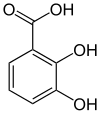2,3-Dihydroxybenzoic acid
 | |
| Names | |
|---|---|
| IUPAC name
2,3-Dihydroxybenzoic acid | |
| Other names
Hypogallic acid; 2-Pyrocatechuic acid; o-Pyrocatechuic acid | |
| Identifiers | |
| Abbreviations | 2,3-DHBA; 2,3-DHB |
| 303-38-8 | |
| ChEBI | CHEBI:18026 |
| ChEMBL | ChEMBL1432 |
| ChemSpider | 18 |
| DrugBank | DB01672 |
| |
| Jmol-3D images | Image Image |
| KEGG | C00196 |
| PubChem | 19 |
| |
| Properties | |
| Molecular formula |
C7H6O4 |
| Molar mass | 154.12 g·mol−1 |
| Appearance | Colorless solid |
| Melting point | 204 to 206 °C (399 to 403 °F; 477 to 479 K) |
| low | |
| Except where noted otherwise, data is given for materials in their standard state (at 25 °C (77 °F), 100 kPa) | |
| | |
| Infobox references | |
2,3-Dihydroxybenzoic acid is a natural phenol found in Phyllanthus acidus[1] and in the aquatic fern Salvinia molesta.[2] It is also abundant in the fruits of Flacourtia inermis. It is a dihydroxybenzoic acid, a type of organic compound. The colorless solid occurs naturally, being formed via the shikimate pathway. It is incorporated into various siderophores, which are molecules that strongly complex iron ions for absorption into bacteria. 2,3-DHB consists of a catechol group, which upon deprotonation binds iron centers very strongly, and the carboxylic acid group by which the ring attaches to various scaffolds via amide linkages. A famous high affinity siderophore is enterochelin, which contains three dihydroxybenzoyl substituents linked to the depsipeptide of serine.[3][4]
It is a potentially useful iron-chelating drug[5]and has antimicrobial properties[6][7][8]
2,3-Dihydroxybenzoic acid is also a product of human aspirin metabolism.[9]
References
- ↑ Sousa M, Ousingsawat J, Seitz R et al. (January 2007). "An extract from the medicinal plant Phyllanthus acidus and its isolated compounds induce airway chloride secretion: A potential treatment for cystic fibrosis". Mol. Pharmacol. 71 (1): 366–76. doi:10.1124/mol.106.025262. PMID 17065237.
- ↑ Choudhary, M. I.; Naheed, N.; Abbaskhan, A.; Musharraf, S. G.; Siddiqui, H.; Atta-Ur-Rahman (2008). "Phenolic and other constituents of fresh water fern Salvinia molesta". Phytochemistry 69 (4): 1018–1023. doi:10.1016/j.phytochem.2007.10.028. PMID 18177906.
- ↑ I. G. O'Brien, G. B. Cox, F. Gibson (1970). "Biologically active compounds containing 2,3-dihydroxybenzoic acid and serine formed by Escherichia coli". Biochimica et Biophysica Acta 201 (3): 453–60. doi:10.1016/0304-4165(70)90165-0. PMID 4908639.
- ↑ Young, I. G.; Gibson, F. (1969). "Regulation of the enzymes involved in the biosynthesis of 2,3-dihydroxybenzoic acid in Aerobacter aerogenes and Escherichia coli". Biochimica et Biophysica Acta (BBA) - General Subjects 177 (3): 401. doi:10.1016/0304-4165(69)90302-X.
- ↑ J. H. Graziano, R. W. Grady and A. Cerami (1974). "The identification of 2,3-dihroxybenzoic acid as a potentially useful iron-chelating drug". JPET 190 (3): 570–575.
- ↑ Shibumon George, Benny PJ, Sunny Kuriakose, Cincy George (2011). "Antibiotic activity of 2, 3-dihydroxybenzoic acid isolated from Flacourtia inermis fruit against multidrug resistant bacteria". Asian Journal of Pharmaceutical and Clinical Research 4 (1).
- ↑ Benny PJ, George Shibumon, Kuriakose Sunny, George Cincy (2010). "2, 3-Dihydroxybenzoic Acid: An Effective Antifungal Agent Isolated from Flacourtia inermis Fruit". International Journal of Pharmaceutical and Clinical Research 2 (3): 101–105.
- ↑ George Shibumon, Benny PJ, Kuriakose Sunny, George Cincy, Gopalakrishnan Sarala (2011). "Antiprotozoal activity of 2, 3-dihydroxybenzoic acid isolated from the fruit extracts of Flacourtia inermis Roxb". Medicinal Plants - International Journal of Phytomedicines and Related Industries 3 (3): 237–241. doi:10.5958/j.0975-4261.3.3.038.
- ↑ Grootveld, M.; Halliwell, B. (1988). "2,3-Dihydroxybenzoic acid is a product of human aspirin metabolism". Biochemical Pharmacology 37 (2): 271–280. doi:10.1016/0006-2952(88)90729-0. PMID 3342084.
| ||||||||||||||||||||||||||||